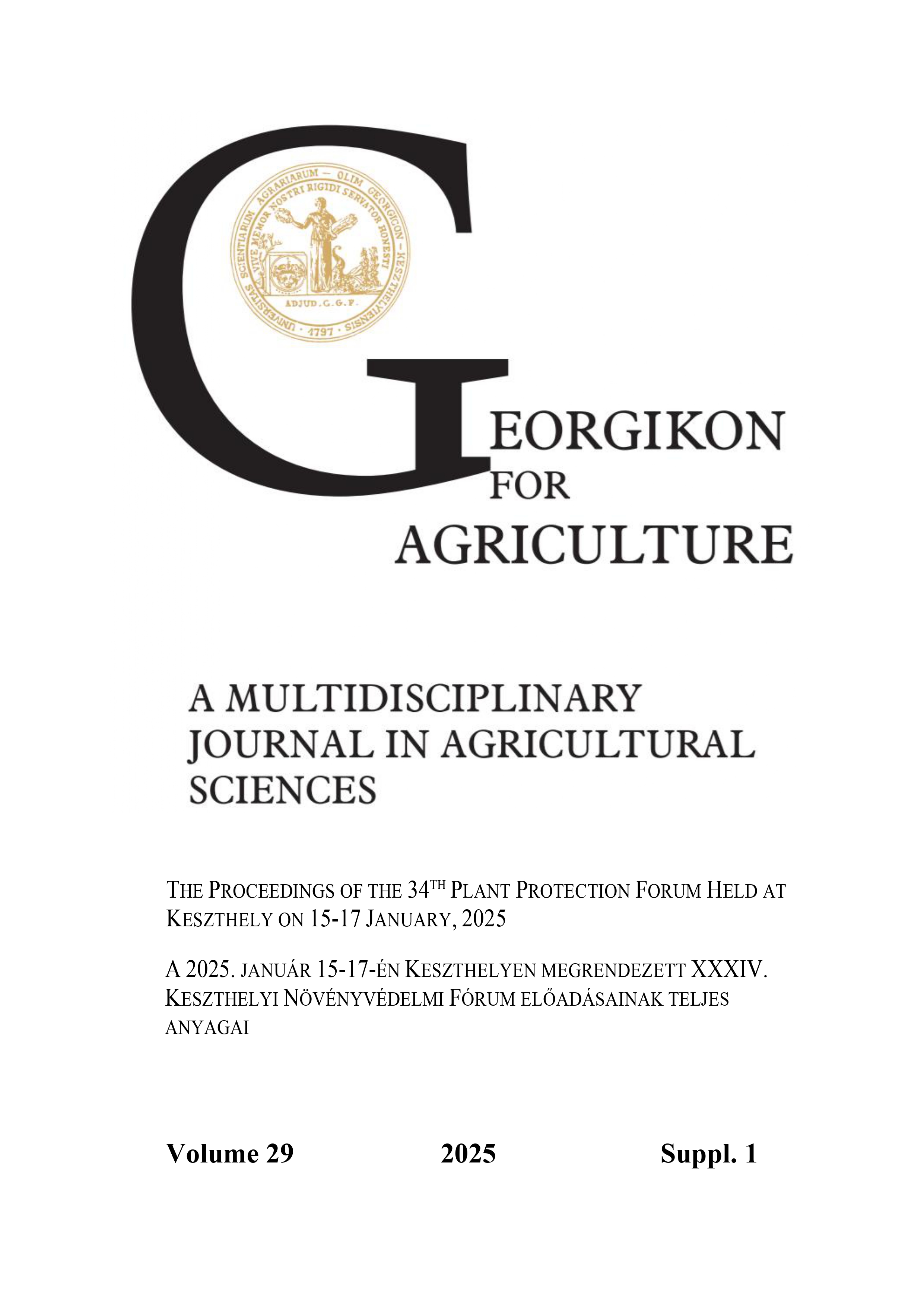Az édesburgonya (Ipomoea batatas) mulcsolásos gyomszabályozási technológiáinak vizsgálata
DOI:
https://doi.org/10.70809/6562Kulcsszavak:
édesburgonya, gyomszabályozás, mulcsolás, talajtakarás, agroszövetAbsztrakt
Kísérletünkben a szerves talajtakaró anyagok (szalmát és fűnyesedéket) továbbá az agroszövet mulcsolás gyomszabályozási hatékonyságát vizsgáltuk. A takaróanyagok csökkentették a gyomborítottságot és befolyásolták a gyomflórát. Hatékonyságuk kb. 4-6 hét elteltével jelentősen csökken, így kiegészítő gyomlálásokra is szükség van, hogy elkerüljük a jelentősebb terméscsökkenést. Az termést agroszövet 43%-kal növelte (ehhez hozzájárulhatott az általa kialakított batáta számára kedvezőbb talajhőmérséklet és vízgazdálkodás is), míg a szerves mulcsok 16-23%-kal csökkentették, még kiegészítő gyomlálásokkal is, a gyomos kontrollban pedig 97,2%-kal csökkent a termés. Az agroszövet 84,25 t/ha míg a szerves talajtakarók 40,98-44,54 t/ha értékesíthető hozamot eredményeztek. Eredményeink alapján az édesburgonya gyomszabályozásra leginkább az agroszövet ajánlható, figyelembe véve a gyomszabályozáshoz szükséges kézimunka idejét és a költségeket is. Mivel az agroszövet több évig használható költsége nem nagyobb a szalma mulcsnál, továbbá a környezeti terhelése is kisebb, mint az egyszer használatos műanyag fóliáknak.
Hivatkozások
Cirujdea, A., Aibar, J., Anzole, Á., Matín-Closas, M., Meco, R., Moreno, M. M., Pardo, A., Pelacho, A. M., Rojo, F., Royo-Esnal, A., Suso, M. L. and Zaradgoza, C. 2012. Biodegradable mulch instead of polyethylene for weed control of processing tomato production. Agronomy for Sustainable Development. 32 889–897. https://doi.org/10.1007/s13593-012-0084-y
Dezső, D. and Pásztor, Gy. 2022. A burgonya alternatív és herbicides gyomszabályozási technológiáinak vizsgálata. Georgikon for Agriculuture. 26 (1) 1–9.
Dezső, D. and Pásztor, Gy. 2024. A szabadföldi támrendszeres paradicsom integrált és alternatív növényvédelmi technológiáinak vizsgálata, Növényvédelem. 60 (1) 26–33.
INTERNET1: https://www.batatapalanta.hu/termesztesi-tudnivalok/ (2024.06.01.)
Kohut, Z. 2023. Édesburgonya: rossz talajokon is aranyat ér a szuperétel, Mezőhír https://mezohir.hu/2023/01/17/agrar-edesburgonya-batata-varaljailaszlo-mezogazdasag/ (2024.06.10.)
Miles, C., Wallace, R., Wszelaki, A., Martin, J., Cowan, J., Walters, T. and Inglis, D. 2012. Deterioration of Potentially Biodegradable Alternatives to Black Plastic Mulch in Three Tomato Production Regions. Horticulture Scince, 47 (9) 1270–1277. https://doi.org/10.21273/HORTSCI.47.9.1270
Pepó, P. 2022. Batáta (édesburgonya) in: Pepó P. (ed.) Integrált növénytermesztés. Alternatív növények. Debreceni Egyetem Kiadó, Debrecen. 199–196. pp.
Schonbeck, M. W. and Evanylo, G. K. 1998a. Effect of Mulches on Soil Properties and Tomato Production I. Soil Temprature, Soil Moisture and Marketable Yield. Journal of Sustainable Agriculture. 13 (1) 55–81. https://doi.org/10.1300/J064v13n01_06
Schonbeck, M. W. and Evanylo, G. K. 1998b. Effect of Mulches on Soil Properties and Tomato Production II. Plant Available Nitrogen, Organic Matter Input and Tilih-Related Properties. Journal of Sustainable Agriculture. 13 (1) 83–100. https://doi.org/10.1300/J064v13n01_07
Seem, J. E., Creamer N. G., Monks, D. W. 2003. Critical Weed-Free Period for ‘Beauregard’ Sweetpotato (Ipomoea batatas). Weed Technology. 17 (4) 686–695. https://doi.org/10.1614/WT02-089
Takácsné Hájos M. and Rubóczki T. 2019. Édesburgonya fajták és hazai termesztésük lehetőségei. Agrofórum 30 (1) 36–39.
Letöltések
Megjelent
Folyóirat szám
Rovat
License
Copyright (c) 2025 Dezső Dániel, Szabó Rita, Pásztor György

This work is licensed under a Creative Commons Attribution-NonCommercial-NoDerivatives 4.0 International License.
The articel is under the Creative Commons 4.0 standard licenc: CC-BY-NC-ND-4.0. Under the following terms: You must give appropriate credit, provide a link to the license, and indicate if changes were made. You may do so in any reasonable manner, but not in any way that suggests the licensor endorses you or your use. You may not use the material for commercial purposes. If you remix, transform, or build upon the material, you may not distribute the modified material. You may not apply legal terms or technological measures that legally restrict others from doing anything the license permits.




 Georgikon for Agriculture
Georgikon for Agriculture